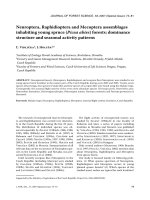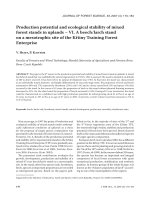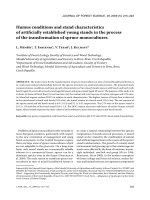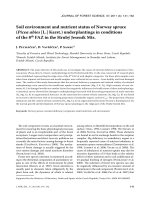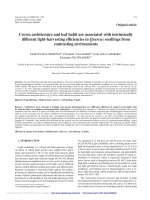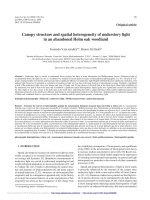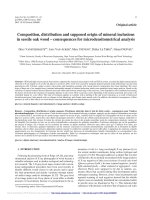Báo cáo lâm nghiệp: "Physiological, morphological and growth responses to rhizosphere hypoxia by seedlings of North American bottomland oaks" potx
Bạn đang xem bản rút gọn của tài liệu. Xem và tải ngay bản đầy đủ của tài liệu tại đây (803.82 KB, 14 trang )
Original
article
Physiological,
morphological
and
growth
responses
to
rhizosphere
hypoxia
by
seedlings
of
North
American
bottomland
oaks
ES
Gardiner
JD
Hodges
Forest
and
Wildlife
Research
Center,
Mississippi
State
University,
Mississippi
State,
MS
36762,
USA
(Received
2
November
1994;
accepted
29
June
1995)
Summary —
Bottomland
oak
species
of
the
southern
United
States
are
distributed
along
topograph-
ical
gradients
in
floodplains.
Because
differences
in
soil
aeration
are
associated
with
these
gradients,
we
tested
the
hypothesis
that
oak
species
will
exhibit
diverging
resistances
to
rhizosphere
hypoxia.
Four
species
which
occupy
different
sites
in
floodplains,
Quercus
lyrata,
Q
laurifolia,
Q
phellos,
and
Q
nigra,
were
used
in
two
experiments
designed
to
examine
seedling
responses
during
establishment
and
late
in
the
first
growing
season.
In
both
experiments,
hypoxia
tolerance
was
evaluated
through
mea-
surements
of
gas
exchange,
biomass
accumulation,
and
shoot
and
root
growth.
Evidence
of
oaks
differing
in
resistance
to
rhizosphere
hypoxia
is
presented,
and
results
are
discussed
in
relation
to
species
distribution
in
floodplains.
rhizosphere
hypoxia
/
Quercus
lyrata
/
Quercus
laurifolia
/
Quercus
phellos
/
Quercus
nigra
/
eco-
physiology
Résumé —
Réponses
physiologiques
et
morphologiques,
et
de
croissance
à
l’hypoxie
rhizo-
sphérique
de
chênes
des
plaines
inondables
d’Amérique
du
Nord.
Certaines
espèces
de
chênes
du
sud
des
États-Unis
sont
distribuées
le
long
de
gradients
topographiques
dans
les
plaines
inon-
dables.
Du
fait
des
différences
dans
l’aération
des
sols
associées
à
ces
gradients,
nous
avons
testé
l’hypothèse
que
ces
espèces
présentent
des
résistances
différentes
à
l’hypoxie
rhizosphérique.
Quatre
espèces
occupant
différents
sites
des
plaines
inondables
(Quercus
lyrata,
Q
laurifolia,
Q
phellos,
et
Q
nigra)
ont
été
soumises
à
deux
expérimentations
pour
évaluer
les
réponses
des
plantes
au
début
et
à
la
fin
de
la
première
saison.
Dans
les
deux
études,
la
tolérance
à
l’hypoxie
a
été
estimée
par
la
mesure
d’échanges
gazeux,
l’accumulation
de
biomasse,
et
la
croissance
de
la
pousse
et
de
la
racine.
Des
dif-
férences
de
résistance
à
l’hypoxie
de
la
rhizosphère
ont
été
mises
en
évidence
et
les
conséquences
sur
la
distribution
des
espèces
dans
les
plaines
inondables
ont
été
discutées.
rhizosphère / hypoxie / Quercus
lyrata / Quercus
laurifolia / Quercus
phellos / Quercus
nigra
/
écophysiologie
*
Current
address:
Southern
Hardwoods
Laboratory,
USDA,
Forest
Service,
PO
Box
227,
Stoneville,
MS
38776,
USA
INTRODUCTION
Microsite
environments
can
profoundly
influ-
ence
the
composition
and
dispersion
of
plants
in
communities.
Soil
surface
hetero-
geneity,
proximity
to
mature
plants,
leaf
lit-
ter
depth,
and
nutrient
distributions
are
a
few
of
the
microsite
attributes
that
can
affect
seed
germination,
establishment,
and
growth
of
herbaceous
and
woody
plants
(Harper
et
al,
1965;
Beatty,
1984;
Hartgerink
and
Bazzaz,
1984;
Fowler,
1986;
Molofsky
and
Augspurger,
1992).
Because
alluvial
sites
are
characteristically
diverse
in
edaphic,
hydrologic,
and
biologic
structure,
several
microsite
types,
which
could
poten-
tially
influence
seedling
establishment
and
growth,
can
be
identified
in
forested
wet-
land
communities
(Marks
and
Harcombe,
1981;
Huenneke
and
Sharitz,
1986, 1990).
Floodplains
have
little
relief,
but
even
slight
elevational
changes
can
affect
vege-
tational
cover
(Tanner,
1986).
Overcup
oak
(Quercus
lyrata
Walt),
swamp
laurel
oak
(Q
laurifolia
Michx),
willow
oak
(Q
phellos
L),
and
water
oak
(Q
nigra
L)
have
been
observed
to
occupy
different
topographical
microsites
within
floodplains
of
the
south-
ern
United
States.
Q
lyrata,
a
member
of
the
subgenus
Leucobalanus,
grows
on
tem-
poral
sloughs
or
low
flats
in
the
floodplain
(Hodges
and
Switzer,
1979;
Tanner,
1986).
These
sites
are
frequently
flooded,
can
remain
saturated
into
the
growing
season,
and
exhibit
poor
internal
soil
aeration
(Put-
nam
et
al,
1960).
Q
lyrata
has
been
classi-
fied
as
the
most
flood-tolerant
of
the
south-
ern
United
States
oaks
(McKnight
et
al,
1981).
Q
laurifolia
is
found
on
low
flats
near
the
periphery
of
temporal
sloughs,
and
is
among
the
most
flood-tolerant
of
oaks
in
the
subgenus
Erythrobalanus
(Putnam
et
al,
1960;
Hodges
and
Switzer,
1979;
McK-
night
et
al,
1981).
Q
phellos,
subgenus
Ery-
throbalanus,
is
typically
found
on
low
flats,
but
at
a
slightly
higher
elevation
than
Q
lau-
rifolia.
It
is
classified
as
more
flood-tolerant
than
Q
nigra
(Putnam
et
al,
1960;
Tanner,
1986).
Q
nigra,
the
least
flood-tolerant
of
these
Erythrobalanus
oaks,
grows
primarily
on
high
flats
or
low
ridges
which
are
the
least
frequently
flooded
positions
in
the
floodplain
(Hodges
and
Switzer,
1979;
Tan-
ner
1986).
Soils
on
these
sites
are
satu-
rated
for
short
periods
and
have
the
best
internal
aeration
(Putnam
et al,
1960).
Woody
plants
established
on
a
floodplain
must
survive
periodic
root
inundation
by
floodwater.
Since
oxygen
is
limiting
in
sat-
urated
soil
(Ponnamperuma,
1984),
terres-
trial
plants
of
wetlands
must
possess
the
ability
to
cope
or
adjust
to
an
anaerobic
rhi-
zosphere.
The
observed
stratification
of
oaks
in
bottomlands,
and
the
apparent
association
of
flood
frequency,
duration,
and
soil
aeration
along
the
topographical
gradi-
ent
has
prompted
this
investigation
of
the
ecophysiological
mechanisms
influencing
resistance
to
root
hypoxia
by
floodplain
tree
regeneration
in
the
genus
Quercus.
This
paper
reports
on
two
experiments
conducted
to test
the
hypothesis
that
bottomland
oak
species
exhibit
different
resistances
to
root
hypoxia.
The
thought
is
that
the
species
which
occupy
the
lowest
sites,
those
sites
which
have
aerobic
soil
for
the
shortest
dura-
tion
in
the
growing
season,
will
demonstrate
the
greatest
resistance
to
root
hypoxia.
The
hypothesis
was
tested
on
seedlings
during
the
establishment
phase
in
Experiment
1,
and
it
was
tested
on
seedlings
late
in
their
first
growing
season
in
Experiment 2.
MATERIALS
AND
METHODS
Experiment
1
Stratified
Q
lyrata,
Q
laurifolia,
Q
phellos,
and
Q
nigra
acorns
were
sown
2.5
cm
deep
in
164
cm
3
tubes
containing
sand.
The
tubes
were
placed
in
a
germinator
programmed
for
8
h
of
light
at
30 °C
and
16
h
of
darkness
at
20 °C
(Bon-
ner
and
Vozzo,
1987).
Sand
was
kept
moist
to
facilitate
acorn
germination.
At
epicotyl
emer-
gence,
seedlings
were
transferred
to
a
hydro-
ponic
network
in
a
greenhouse
where
they
were
established
in
a
0.1
strength
Hoagland
#2
nutrient
solution
(pH
=
5.5)
(Jones,
1983).
The
hydroponic
network,
built
after
a
system
described
by
Topa
and
McLeod
(1986),
consisted
of
two
208
L
nutrient
solution
reservoirs,
thirty
18.9
L
plastic
pots,
and
appropriate
plumbing.
Each
pot
received
non-circulating
nutrient
solution
so
that
3.8
L
of
solution
was
replaced
every
24
h.
Nutrient
solution
in
each
pot
was
bubbled
with
either
O2
or
N2
depending
on
treatment
assign-
ment
(Topa
and
McLeod,
1986).
N2
was
used
to
maintain
dissolved
oxygen
(DO)
concentration
at
<
0.2
mg
L
-1
for
pots
designated
to
receive
the
hypoxic
rhizosphere
treatment.
O2
was
used
to
maintain
solution
DO
concentration
at
>
15
mg
L
-1
for
pots
receiving
the
normoxic
rhi-
zosphere
treatment.
O2
was
used
rather
than
air
to
ensure
a
homogeneously
aerobic
rhizosphere.
Four
seedlings,
one
of
each
species,
in
the
stage
of
epicotyl
emergence
were
randomly
assigned
to
each
of
30
pots.
Plants
were
main-
tained
in
nutrient
solution
for
54
days
with
half
of
the
pots
receiving
hypoxic
nutrient
solution,
and
the
other
half
receiving
normoxic
nutrient
solu-
tion.
At
d6
of
this
experiment
it
was
determined
that
seedlings
receiving
the
hypoxic
nutrient
solu-
tion
would
all
soon
die.
Shoots
were
withering
and
roots
had
not
grown,
so
these
seedlings
were
given
a
24
day
recovery
period
of
normoxic
nutri-
ent
solution.
After
leaves
developed
during
the
recovery
period,
seedlings
once
again
received
hypoxic
nutrient
solution
for
the
remainder
of
the
experiment.
On
each
of
3
days
near
the
end
of
the
54
day
experiment,
leaf
gas
exchange
variables
were
measured
on
three
seedlings
of
each
species
and
treatment.
On
each
seedling,
one
median
leaf
in
a
lag-stage
flush
was
selected
for
mea-
surement
(Hanson
et
al,
1986).
A
LCA-3
CO
2
analyzer
(The
Analytical
Development
Co
Ltd,
UK)
was
used
to
measure
CO
2
exchange
rates
and
determine
intercellular
CO
2
on
these
leaves
under
saturating
light
(≥
800
μmol
m
-2
s
-1
pho-
tosynthetically
active
photon
flux
density
(PPFD)
(Gardiner
and
Hodges,
unpublished).
Supple-
mental
light
was
provided
with
a
fan-cooled,
high
pressure
sodium
lamp
when
ambient
light
was
not
saturating.
Transpiration
and
stomatal
con-
ductance
for
these
same
leaves
were
measured
with
a
Li-1600
Steady
State
Porometer
(Licor
Inc,
Lincoln,
NE,
USA).
All
gas
exchange
measure-
ments
were
taken
randomly
for
species
and
treat-
ment
combinations
between
1000
and
1200
hours
on
each
sample
day.
At the
end
of
the
experi-
ment,
leaf
samples
for
carbon
isotope
analysis
were
secured
from
five
randomly
chosen
pots
in
each
treatment.
Dried
leaf
material
was
ground
to
pass
#40
mesh,
and
analyzed
for
stable
carbon
isotope
ratios
at
the
Bioscience
Laboratory,
Uni-
versity
of
Utah,
USA.
Leaf
tissue
was
analyzed
for
stable
isotope
ratios
because
we
thought
this
variable
would
serve
as
an
integrated
index
of
stomatal
aperature
during
rhizosphere
hypoxia.
After
the
54
day
experiment,
all
120
seedlings
were
harvested
and
dissected
into
leaves,
stems
and
roots.
These
dried
biomass
components
were
used
as
indices
of
proportional
biomass
accu-
mulation,
leaf
weight
ratio
(LWR)
=
leaf
weight
/total
plant
weight,
stem
weight
ratio
(SWR)
=
stem
weight/total
plant
weight,
root
weight
ratio
(RWR)
=
root
system
weight/total
plant
weight,
root/stem
ratio
(R/S
ratio)
=
root
system
weight/stem
weight.
Relative
height
and
diameter
growth
were
calculated
from
initial
and
final
stem
heights
and
diameters.
Experiment
2
Stratified
acorns
from
Q
lyrata,
Q
laurifolia,
Q
phel-
los
and
Q
nigra
were
planted
in
0.9
L
containers
of
a
50%
potting
soil:
50%
sand
mixture
(v:v).
Containers
were
placed
in
a
greenhouse
where
seedlings
were
grown
for
about
4
months.
Ran-
domly
selected
lag-stage
seedlings
were
removed
from
their
original
containers,
soil
was
carefully
washed
away
from
roots,
and
these
seedlings
were
immediately
transferred
to
a
hydroponic
net-
work.
Four
seedlings,
one
of
each
species,
were
randomly
assigned
to
one
of
40
pots
in
the
hydro-
ponic
network.
The
network
and
nutrient
solution
were
the
same
as
those
described
in
Experiment
1.
After
2
weeks
of
seedling
acclimation,
20
pots
were
randomly
assigned
a
35
day
treatment
of
hypoxic
nutrient
solution,
and
20
pots
were
main-
tained
in
normoxic
nutrient
solution
as a
control.
Stomatal
conductance
and
transpiration
were
measured
3
days
before
the
treatment
and
on
days
1-10,
15, 20, 25, 30,
and
35
of
the
treat-
ment.
These
variables
were
measured
on
one
fully
expanded
leaf
from
four
seedlings
in
the
same
morphological
stage
while
a
portable
lamp
maintained
PPFD
on
the
leaf
between
400
and
800
μmol
m
-2
s
-1
.
Stomatal
conductance
and
transpiration
were
measured
randomly
for
species
and
treatment
combinations
between
0900
and
1100
hours
on
each
sample
day.
Diurnal
stomatal
conductance
and
transpiration
measurements
were
randomly
taken
for
each
treatment
and
species
combination
at
2
h
intervals
beginning
at
0600
hours,
and
finishing
at
2000
hours
on
4
days
during
the
last
week
of
the
experiment.
On
each
selected
seedling,
one
fully
expanded
leaf
on
a
predetermined
flush
was
measured
under
ambient
light.
Following
the
experiment,
15
seedlings
in
each
treatment
and
species
combination
were
har-
vested
and
dissected
into
leaves,
stems,
and
roots.
LWR,
SWR,
RWR,
and
R/S
ratios
were
calculated
from
the
dried
biomass
components.
Relative
height
and
diameter
growth
were
calcu-
lated
from
stem
heights
and
diameters
measured
on
days
1
and
35.
For
both
experiments,
data
were
analyzed
according
to
a
split-plot
design
with
Statistical
Analysis
System
software
(SAS
Version
6.04,
SAS
Institute,
Cary,
NC,
USA).
DO
level
was
the
whole
plot
and
species
were
the
split-plot.
If
the
treatment
x
species
interaction
term
was
signifi-
cant
at
a
=
0.05,
treatment
combination
means
were
separated
with
a
LSD
computed
for
the
dif-
ference
between
two
whole
plot
means
at
the
same
or
different
levels
of
the
split-plot
mean
(Petersen,
1985).
If
the
treatment
x
species
inter-
action
term
was
not
significant,
it
was
pooled
into
the
error
term
to
test
significance
of
the
treatment
effect.
RESULTS
Experiment
1
Net
photosynthesis
and
transpiration
were
reduced
by
78
and
86%,
respectively,
on
plants
established
in
hypoxic
nutrient
solu-
tion
(table
I).
Decline
in
net
photosynthesis
and
transpiration
can
be
attributed
to
par-
tial
stomatal
closure,
because
stomatal
con-
ductance
decreased
84%
for
plants
estab-
lished
in
hypoxic
nutrient
solution
(table
I).
In
this
experiment,
leaf
gas
exchange
did
not
vary
by
species
under
rhizosphere
hypoxia.
The
δ
13
C
for
plants
established
in
hypoxic
nutrient
solution
averaged
about
1‰
below
that
of
plants
established
in
hypoxic
nutri-
ent
solution
(table
I).
Calculated
ratios
of
net
photosynthesis/intercellular
CO
2
were
greatest
for
all
oak
seedlings
established
in
normoxic
nutrient
solution,
and
averaged
about
81%
less
for
seedlings
established
in
hypoxic
nutrient
solution
(table
I).
Total
plant
biomass
of
seedlings
estab-
lished
in
hypoxic
nutrient
solution
was
40%
less
than
that
of
seedlings
established
in
normoxic
nutrient
solution.
Biomass
accu-
mulation
decreased
22%
in
leaves,
21 %
in
stems,
and
61
%
in
roots
for
all
oak
species.
In
addition
to
the
depressed
biomass
accu-
mulation,
proportional
biomass
accumula-
tion
in
plant
components
shifted
for
seedlings
established
in
hypoxic
nutrient
solution
(table II).
For
all
oaks,
roots
comprised
about
38%
of
total
plant
biomass,
but
establishment
in
hypoxic
nutrient
solution
reduced
RWRs
by
36%
(table
II).
Therefore,
seedling
estab-
lishment
in
hypoxic
nutrient
solution
increased
proportional
biomass
accumula-
tion
in
shoots,
but
relative
change
in
SWR
and
LWR
differed
by species
(table
II).
Q
nigra
showed
an
increase
in
LWR
when
established
in
hypoxic
nutrient
solution,
but
the
other
species
showed
an
increase
in
LWR
and
SWR.
When
established
in
hypoxic
nutrient
solution,
Q
nigra
and
Q phellos
maintained
proportionately
more
leaf
biomass
than
Q
laurifolia
and
Q
lyrata
(table
II).
But
Q
lyrata
and
Q
laurifolia
main-
tained
proportionately
more
stem
biomass
than
Q phellos and
Q nigra
seedlings
under
rhizosphere
hypoxia
(table
II).
R/S
ratios of
all
species
decreased
about
44%
when
established
in
hypoxic
nutrient
solution
(table
II).
Though
total
plant
weight
differed
between
rhizosphere
treatments,
R/S
ratio
was
weakly
correlated
with
total
plant
biomass
(correlation
coefficient
=
0.24).
Relative
height
growth
of
seedlings
established
in
normoxic
nutrient
solution
was
72%
greater
than
relative
height
growth
seedlings
established
in
hypoxic
nutrient
solution.
Seedlings
established
in
normoxic
nutrient
solution
grew
131 %
larger
in
diam-
eter
than
seedlings
established
in
hypoxic
nutrient
solution.
However,
neither
relative
height
growth
or
relative
diameter
growth
varied
by
species
when
established
in
hypoxic
nutrient
solution.
Experiment
2
For
all
species,
rhizosphere
hypoxia
reduced
stomatal
conductance
below
that
of
control
seedlings
by
d3
of
the
treatment
(fig
1).
From
d3
through
termination
of
the
experiment,
stomatal
conductance
of
stressed
seedlings
remained
lower
than
control
seedlings,
except
for
d20.
On
d20,
high
relative
humidity
in
conjunction
with
low
PAR
probably
reduced
the
treatment’s
effect
on
stomatal
conductance
(fig
1).
Significant
treatment
x
species
interac-
tions
on
d5,
and
d7-d10
indicated
stom-
atal
conductance
of
stressed
seedlings
differed
by
species.
During
this
time,
Q
lyrata
stomatal
conductance
was
not
reduced
by
rhizosphere
hypoxia.
On
d5
and
d7,
Q
laurifolia
stomatal
conductance
was
lower
on
plants
in
hypoxic
nutrient
solution.
Between
d5
and
d10,
stomatal
conductance
for
Q
phellos
and
Q
nigra
seedlings
in
hypoxic
nutrient
solution
aver-
aged
35%
lower
than
seedlings
in
nor-
moxic
nutrient
solution.
Observed
reduc-
tions
in
transpiration
resulting
from
rhizosphere
hypoxia
generally
paralleled
declines
in
stomatal
conductance.
On
12
of
the
15
sample
days,
seedlings
grow-
ing
in
hypoxic
nutrient
solution
maintained
lower
transpiration
rates
than
control
seedlings.
Similar
to
stomatal
conduc-
tance,
transpiration
rates
on
d5,
and
d7-d10
varied
by
species.
Diurnal
patterns
of
stomatal
conductance
were
similar
for
all
species,
but
magnitude
differed
by
DO
treatment
(fig
2).
Stomatal
conductance
of
control
seedlings
increased
to
0.26
±
0.02
cm
s
-1
at
1000
hours,
decreased
around
midday,
and
slightly
increased
at
1600
hours
before
falling
at
night
(fig
2).
Stomatal
conductance
was
greatest
on
stressed
seedlings
at
1000
hours
when
it
averaged
0.13
± 0.02
cm
s
-1
.
At
the
0800
hours
sample
period,
stomatal
conductance
of
Q
laurifolia,
Q phellos,
and
Q
nigra
seedlings
growing
in
hypoxic
nutri-
ent
solution
showed
lower
rates
than
control
seedlings.
However,
stomatal
conductance
of
Q
lyrata
was
not
influenced
by
the
treat-
ment
at
this
sample
time.
For
all
species,
stomatal
conductance
during
the
’midday
slump’
was
85%
of
the
maximum
conduc-
tance
rate
in
control
seedlings,
but
it
was
77%
of
the
maximum
conductance
rate
in
stressed
plants.
Diurnal
patterns
of
transpi-
ration
paralleled
those
of
stomatal
conduc-
tance.
For
these
older
seedlings,
roots
were
the
only
plant
component
in
which
biomass
accumulation
was
significantly
reduced
by
35
days
of
rhizosphere
hypoxia.
Root
sys-
tems
grown
in
normoxic
nutrient
solution
averaged
47%
more
biomass
than
those
grown
in
hypoxic
nutrient
solution
(data
not
shown).
In
spite
of
the
decrease
in
root
biomass
accumulation,
total
plant
biomass
accumulation
was
not
changed
by
35
days
of
rhizosphere
hypoxia.
However,
shifts
in
proportional
biomass
accumulation
were
found
after
35
days
of
rhizosphere
hypoxia.
LWRs
varied
by
species
within
nutrient
solution
type
(table
III).
Q
lyrata
and
Q
nigra
seedlings
grown
in
hypoxic
nutrient
solu-
tion
had
proportionally
more
leaf
biomass
than
plants
grown
in
normoxic
nutrient
solu-
tion
(table
III).
LWR
for
Q
laurifolia
was
not
changed
by
rhizosphere
hypoxia,
but
the
LWR
of
Q
phellos
declined
19%
in
hypoxic
nutrient
solution.
Q
nigra
showed
the
great-
est
LWR
in
both
nutrient
solutions
(table
III).
For
all
oaks,
SWR
increased
44%
under
35
days
of
rhizosphere
hypoxia
(table
III).
For
three
of
four
oak
species,
RWR
decreased
during
35
days
of
rhizosphere
hypoxia
(table
III).
This
shift
placed
Q
nigra
below
the
other
three
species
in
terms
of
the
proportion
of
root
biomass
maintained
under
rhizosphere
hypoxia.
For
all
species,
R/S
ratios
were
40%
lower
when
seedlings
were
raised
in
hypoxic
nutrient
solution
(table
III).
In
this
experiment,
two
lines
of
evidence
indicate
differences
in
R/S
ratios
were
allocation
responses
rather
than
a
function
of
total
plant
biomass.
First,
total
plant
biomass
did
not
differ
between
plants
grown
in
hypoxic
and
normoxic
nutrient
solution.
And,
the
cor-
relation
between
R/S
ratio
and
total
plant
biomass
was
very
low
(correlation
coeffi-
cient
= -0.30).
Relative
height
and
diameter
growth
for
seedlings
grown
in
hypoxic
nutrient
solu-
tion
differed
by
species
(table
IV).
Q
lyrata
relative
height
growth
was
small
and
did
not
differ
in
response
to
rhizosphere
hypoxia.
The
lack
of
growth
in
this
species
may
relate
to
its
late-season
phenology.
Among
the
Erythrobalanus
species,
Q
laurifolia
grew
equally
well
in
either
solution.
However,
Q
phellos
and
Q
nigra
seedlings
in
hypoxic
solution
attained
only
30%
of
the
relative
height
growth
of
seedlings
in
normoxic
solu-
tion
(table
IV).
Under
rhizosphere
hypoxia,
average
Q
lyrata
diameter
growth
was
over
3.5
times
larger
than
for
seedlings
grown
in
normoxic
solutions
(table
IV).
Q
laurifolia
seedlings
in
hypoxic
solutions
grew
over
1.8
times
larger
in
diameter
than
seedlings
in
normoxic
solutions
(table
IV).
Thirty-five
days
of
rhizosphere
hypoxia
did
not
change
relative
diameter
growth
for
Q
phellos
and
Q
nigra
seedlings
(table
IV).
DISCUSSION
AND
CONCLUSIONS
Short-term
photosynthetic
decline
for
plants
growing
in
saturated
soil
is
often
ascribed
to
partial
closure
of
stomates
(Peterson
and
Bazzaz,
1984;
Pezeshki
and
Chambers,
1985a,
b;
Tsukahara
and
Kozlowski,
1986).
Stomatal
closure
can
reduce
net
photo-
synthesis
by
limiting
the
intercellular
CO
2
concentration
available
for
assimilation
(Kozlowski
and
Pallardy,
1984).
In
Experi-
ment
1,
significant
decline
in
net
photo-
synthesis
was
observed
concomitant
to
reduced
stomatal
aperture.
However,
non-
stomatal
limitations
to
photosynthesis
may
also
be
observed
after
extended
periods
of
root
hypoxia
(McLeod
et
al,
1986;
Dreyer
et
al,
1991;
Beckman
et
al,
1992;
Vu
and
Yelenosky,
1992).
Kozlowski
and
Pallardy
(1984)
suggested
that
nonstomatal limita-
tion
to
photosynthesis
during
soil
satura-
tion
may
include
decline
in
chlorophyll
con-
centration
and
changes
in
carboxylation
enzymes.
In
Experiment
1,
leaves
of
plants
established
under
rhizosphere
hypoxia
appeared
more
chlorotic
than
the
leaves
on
plants
established
in
normoxic
nutrient
solution.
Two
stronger
lines
of
evidence
indicate
that
nonstomatal
mechanisms
con-
tributed
to
limiting
net
photosynthesis
of
oaks
established
in
hypoxic
nutrient
solu-
tion.
First,
ratios
of
net
photosynthesis/inter-
cellular
CO
2
decreased
under
rhizosphere
hypoxia
indicating
a
decline
in
assimilated
CO
2
per
unit
of
available
CO
2.
And,
a
decrease
in
δ
13
C
was
observed
on
plants
established
under
rhizosphere
hypoxia
indi-
cating
greater
enzymatic
discrimination
against
13C.
Greatest
discrimination
would
be
expected
in
leaves
having
the
largest
Ci
/C
a
ratios
(Farquhar
et
al,
1982).
For
example,
if
CO
2
assimilation
was
reduced
relatively
more
than
stomatal
conductance
(Guy
and
Wample,
1984).
In
this
study,
stomatal
and
possible
nonstomatal
mech-
anisms
appeared
to
limit
net
photosynthe-
sis
of
oaks
established
in
hypoxic
nutrient
solution.
However,
all
species
showed
a
similar
decrease
in
net
photosynthesis
when
established
in
hypoxic
nutrient
solu-
tion.
Partial
stomatal
closure
can
also
account
for
decreased
transpiration
under
anaerobic
soil
conditions,
because
transpiration
is
often
observed
to
decline
without
a
con-
current
change
in
leaf
water
potential
(Pezeshki
and
Chambers,
1986;
Osonubi
and
Osundina,
1987).
Quick
stomatal
response
to
soil
flooding
decreased
tran-
spiration
within
2
days
of
soil
flooding
for
Q pagoda
(Raf),
Q
michauxii (Nutt),
and
Q
macrocarpa
(Michx)
(Tang
and
Kozlowski,
1982b;
Pezeshki
and
Chambers,
1985a,
1986).
In
Experiment
1,
transpiration
of
seedlings
established
in
hypoxic
nutrient
solution
appeared
to
be
limited
primarily
by
stomatal
closure,
and
it
decreased
similarly
for
all
species.
For
the
older
seedlings,
greatest
stomatal
disfunction
was
recorded
between
d5
and d10
of
the
stress.
During
this
period,
Q
lyrata
seedlings
were
effected
the
least.
Q
phellos
and
Q
nigra
showed
the
greatest
decline
in
stomatal
function
during
this
period.
Diurnal
patterns
of
stomatal
conduc-
tance
and
transpiration
observed
in
the
second
experiment
were
in
general
agree-
ment
with
published
results
on
other
species
grown
in
flooded
soil.
Stomatal
conductance
is
often
reduced
during
mid-
day,
but
the
degree
of
reduction
is
typically
greatest
in
stressed
plants
(Tang
and
Kozlowski,
1982a,b).
Relative
to
control
plants,
seedlings
grown
in
hypoxic
nutri-
ent
solution
exhibited
lower
stomatal
con-
ductance
and
transpiration
rates,
and
pro-
portionally
greater
midday
fluctuations
of
these
parameters.
Treatment
effects
on
Q
lyrata
stomatal
function
were
realized
later
in
the
day
than
on
the
other
three
species.
Rhizosphere
hypoxia
induced
morpho-
logical
changes
in
leaves,
stems,
and
roots
for
seedlings
of
both
age
classes.
Root
hypoxia
can
stimulate
changes
in
leaf
mor-
phology
by
promoting
abscission,
reducing
expansion
rate,
or
preventing
leaf
forma-
tion
(Sena
Gomes
and
Kozlowski,
1980b;
Smit
et
al,
1990;
Terazawa
and
Kikuzawa,
1994).
Leaf
abscission
was
not
observed
in
either
experiment,
but
LWRs
increased
for
all
plants
receiving
rhizosphere
hypoxia.
In
both
experiments,
Q
lyrata
and
Q
laurifolia
maintained
the
smallest
proportion
of
leaf
biomass
under
rhizosphere
hypoxia,
while
Q
nigra
maintained
the
highest
LWR
under
rhizosphere
hypoxia.
Stems
of
seedlings
established
in
hypoxic
nutrient
solution
were
20%
smaller
in
mass
than
those
of
seedlings
established
in
nor-
moxic
nutrient
solution.
Q
lyrata
and
Q
lau-
rifolia
maintained
a
larger
proportion
of
stem
biomass
than
Q
phellos
and
Q
nigra,
when
established
under
rhizosphere
hypoxia.
SWRs
of
the
older
seedlings
were
similar
for
all
species
under
rhizosphere
hypoxia.
Other
hardwood
mesophytes
usually
show
a
reduction
in
stem
dry
weight
resulting
from
root
hypoxia
(Hosner
and
Boyce, 1962;
Dickson
et
al,
1965;
Tang
and
Kozlowski,
1982b),
but
4
months
of
soil
flooding
did
not
change
RWR
of
Q
pagoda
seedlings
(Jones
et al,
1989).
Root
biomass
is
often
reduced
during
short-term
soil
flooding,
even
on
hydric
species
such
as
Taxodium
distichum
L
(McLeod
et
al,
1986).
Roots
may
show
reduced
biomass
in
anaerobic
soil
because
of
reduced
growth
or
decomposition
(Hook
and
Brown,
1973;
Angeles
et
al,
1986).
In
these
experiments,
evidence
of
root
system
decomposition
was
not
visible.
So,
differ-
ences
in
root
biomass
accumulation
are
attributed
to root
growth
differences
between
treatments.
During
seedling
establishment,
RWR
was
decreased
similarly
for
all
species.
But
in
hypoxic
nutrient
solution,
Q
nigra
maintained
the
proportionately
smallest
root
system
among
the
older
seedlings.
Several
authors
have
argued
that
reduced
root
growth
on
seedlings
in
flooded
soil
will
decrease
post-flood
drought
toler-
ance
of
these
seedlings
(Tang
and
Kozlowski,
1982a,b;
Sena
Gomes
and
Kozlowski
1980b).
In
this
study,
decreased
root
mass
and
relatively
high
proportions
of
leaf
mass
may
predispose
Q
phellos
and
Q
nigra
to
slow
post-flood
recovery.
In
both
experiments,
proportional
biomass
accumulation
was
shifted
towards
the shoot.
R/S
ratio
of
plants
receiving
hypoxic
nutrient
solution
were
lower
than
those
of
plants
receiving
normoxic
nutrient
solution.
This
occurred
apart
from
decreases
in
total
plant
biomass
on
the
stressed
seedings.
Topa
and
McLeod
(1986)
found
a
similar
root-shoot
response
for
conifer
seedlings
which
were
grown
in
anaerobic
nutrient
solution.
In
contrast,
two
Eucalyptus
species
showed
proportionately
more
root
growth
than
shoot
growth,
this
was
primarily
a
result
of
adventitious
root
generation
and
leaf
abscission
under
con-
ditions
of
anaerobic
soil
(Sena
Gomes
and
Kozlowski
1980a).
Soil
saturation
during
the
growing
sea-
son
typically
reduces
shoot
growth
of
older,
mesophytic
seedlings
(Dickson
et
al,
1965;
Gill,
1970;
Topa
and
McLeod,
1986).
Though
most
of
the
energy
and
carbon
required
for
initial
shoot
growth
is
provided
by
the
acorn
(Crow,
1988),
rhizosphere
hypoxia
limited
shoot
growth
of
all
oaks
dur-
ing
seedling
establishment
(Experiment
1).
Thus,
a
functional
root
system
is
required
to
realize
potential
shoot
growth
of
seedlings
during
establishment.
For
the
older
seedlings,
relative
growth
responses
to
rhi-
zosphere
hypoxia
varied
by
species.
Rela-
tive
height
growth
of
Q phellos
and
Q
nigra
were
reduced
69%
in
hypoxic
nutrient
solu-
tion.
However,
Q
lyrata
and
Q
laurifolia
rel-
ative
diameter
growth
increased
under
rhi-
zosphere
hypoxia.
Increased
diameter
growth
has
been
observed
on
other
species
grown
in
flooded
soil,
and
attributed
to
stem
hypertrophy
(Yamamoto
et
al,
1987).
In
this
study,
rhizosphere
hypoxia
may
have
induced
enlargement
of
the
basal
portion
of
stems,
but
there
was
not
excessive
stem
hypertrophy
as
reported
for
other
species
subjected
to
soil
flooding
(Gardiner,
1994).
Micromorphological
examinations
have
failed
to
reveal
aerenchyma
formation
by
these
and
other
bottomland
oaks
of
the
southern
United
States
(Pezeshki,
1991;
Gardiner,
1994).
Results
from
the
first
experiment
indi-
cated
early
exposure
to
hypoxic
nutrient
solution
was
equally
lethal
to
all
establish-
ing
species.
However,
seedlings
allowed
to
recover
demonstrated
that
shifts
in
plant
morphology
may
be
important
for
resis-
tance
to
root
hypoxia
during
seedling
estab-
lishment.
High
LWRs
along
with
significant
reductions
in
root
mass
place
Q
phellos
and
Q
nigra
as
the
least
resistant
to
root
hypoxia
during
seedling
establishment.
Species
resistance
to
rhizosphere
hypoxia
during
seedling
establishment
could
not
be
separated
through
physiological
or
growth
responses.
For
the
older
seedlings,
Q
lyrata
and
Q
laurifolia
showed
early
physiologi-
cal
resistance,
a
morphology
most
con-
ducive
to
survival
under
rhizosphere
hypoxia,
and
better
shoot
growth
than
Q
phellos
and
Q
nigra.
These
findings
do
not
completely
explain
bottomland
oak
dis-
tribution
in
floodplains,
and
the
results
may
have
been
different
if
seedlings
were
raised
in
soil
rather
than
nutrient
solution.
How-
ever,
these
findings
indicate
that
low
oxygen
partial
pressures
around
roots
can
influ-
ence
bottomland
oak
physiology,
morphol-
ogy
and
growth.
Thus,
it
potentially
plays
a
strong
role
in
determining
establishment,
survival
and
growth
of
bottomland
oak
regeneration.
ACKNOWLEDGMENTS
We
thank
the
many
people
who
assisted
with
design
and
implementation
of
this
research.
Two
anonymous
reviewers
are
thanked
for
their
con-
structive
comments
on
an
earlier
draft
of
this
manuscript.
This
article
has
been
approved
for
publication
as
Journal
Article
No
FA-035-0695
of
the
Forest
and
Wildlife
Research
Center,
Mis-
sissippi
State
University.
REFERENCES
Angeles
G,
Evert
RF,
Kozlowski
TT
(1986)
Develop-
ment
of
lenticels
and
adventitious
roots
in flooded
Ulmus
americana
seedlings.
Can
J
For
Res
16,
585-
590
Beatty
SW
(1984)
Influence
of
microtopography
and
canopy
species
on
spatial
patterns
of
forest
under-
story
plants.
Ecology 65, 1406-1419
Beckman
TG,
Perry
RL,
Flore
JA
(1992)
Short-term
flooding
affects
gas
exchange
characteristics
of
containerized
sour
cherry
trees.
Hort Sci 27,
1297-
1301
Bonner
FT,
Vozzo
JA
(1987)
Seed
biology
and
tech-
nology
of
Quercus.
USDA,
Forest
Service,
Gen
Tech
Rep SO-66
Crow TR
(1988)
Reproductive
mode
and
mechanisms
for
self-replacement
of
northern
red
oak
(Quercus
rubra) -
a
review.
For
Sci
34,
19-40
Dickson
RE,
Hosner JF,
Hosley
NW
(1965)
The
effects
of
four
water
regimes
upon
the
growth
of
four
bot-
tomland
tree
species.
For
Sci 11,
299-305
Dreyer
E,
Colin-Belgrand
M,
Biron
P
(1991)
Photosyn-
thesis
and
shoot
water
status
of
seedlings
from
dif-
ferent
oak
species
submitted
to
waterlogging.
Ann
Sci
For 48, 205-214
Farquhar
GD,
O’Leary
MH,
Berry
JA
(1982)
On
the
rela-
tionship
between
carbon
isotope
discrimination
and
the
intercellular
carbon
dioxide
concentration
in
leaves.
Aust
J Plant
Physiol 9,
121-137
Fowler
NL
(1986)
Microsite
requirements
for
germination
and
establishment
of
three
grass
species.
Am
Midl
Nat 115, 131-145
Gardiner
ES
(1994)
Physiological
responses
of
four
bot-
tomland
oak
species
to
root
hypoxia.
PhD
Disser-
tation,
Mississippi
State
University
Gill
CJ
(1970)
The
flooding
tolerance
of
woody
species
-
a review.
For
Abst
31, 671-688
Guy
RD,
Wample
RL
(1984)
Stable
carbon
isotope
ratios
of
flooded
and
nonflooded
sunflowers
(Helianthus
annuus). Can J Bot 62, 1770-1774
Hanson
PJ,
Dickson
RE,
Isebrands JG,
Crow TR,
Dixon
RK
(1986)
A
morphological
index
of
Quercus
seedling
ontogeny
for
use
in
studies
of
physiology
and
growth.
Tree
Physiol 2,
273-281
Harper
JL,
Williams
JT,
Sagar
GR
(1965)
The
behaviour
of
seeds
in
soil.
I.
The
heterogeneity
of
soil
surfaces
and
its
role
in
determining
the
establishment
of
plants
from
seed.
J Ecol 53,
273-286
Hartgerink AP,
Bazzaz
FA
(1984)
Seedling-scale
envi-
ronmental
heterogeneity
influences
individual
fit-
ness
and
population
structure.
Ecology 65,
198-
206
Hodges
JD,
Switzer
GL
(1979)
Some
aspects
of
the
ecology
of
southern
bottomland
hardwoods.
In:
North
America’s
Forests:
Gateway
To
Opportunity.
Pro-
ceedings
of
the
1978
Joint
Convention
of
the
Society
of
American
Foresters
and
the
Canadian
Institute
of
Forestry,
Society
of
American
Foresters,
Wash-
ington,
DC,
360-365
Hook
DD,
Brown
CL
(1973)
Root
adaptations
and
rela-
tive
flood
tolerance
of
five
hardwood
species.
For
Sci
19,
225-229
Hosner
JF,
Boyce
SG
(1962)
Tolerance
to
water
satu-
rated
soil
of
various
bottomland
hardwoods.
For Sci
8, 180-186
Huenneke
LF,
Sharitz
RR
(1986)
Microsite
abundance
and
distribution
of
woody
seedlings
in
a
South
Car-
olina
cypress-tupelo
swamp. Am
Midl
Nat
115,
328-
335
Huenneke
LF,
Sharitz
RR
(1990)
Substrate
heterogeneity
and
regeneration
of
a
swamp
tree,
Nyssa
aquatica.
Am
J
Bot
77,
413-419
Jones
JB
Jr,
(1983)
A
Guide
for
the
Hydroponic
and
Soil-
less
Culture
Grower.
Timber
Press,
Portland,
OR
Jones
RH,
Sharitz
RR,
McLeod
KW
(1989)
Effects
of
flooding
and
root
competition
on
growth
of
shaded
bottomland
hardwood
seedlings.
Am
Midl
Nat
121,
165-175
Kozlowski
TT,
Pallardy
SG
(1984)
Effects
of
flooding
on
water,
carbohydrate,
and
mineral
relations.
In:
Flood-
ing
and
Plant
Growth
(TT
Kozlowski,
ed),
Academic
Press
Inc,
Orlando,
FL,
165-193
Marks
PL,
Harcombe
PA
(1981)
Forest
vegetation
of
the
Big
Thicket,
southeast
Texas.
Ecol
Monog
51,
287-305
McKnight
JS,
Hook
DD,
Langdon
OG,
Johnson
RL
(1981)
Flood
tolerance
and
related
characteristics
of
trees
of
the
bottomland
forests
of
the
southern
United
States.
In:
Wetlands
of
Bottomland
Hard-
wood
Forests
(JR
Clark,
J
Benforado,
eds),
Else-
vier
Scientific
Pub
Co,
New
York,
29-69
McLeod
KW,
Donovan
LA,
Stumpff
NJ,
Sherrod
KC
(1986)
Biomass,
photosynthesis
and
water
use
effi-
ciency
of
woody
swamp
species
subjected
to
flood-
ing
and
elevated
water
temperature.
Tree
Physiol
2, 341-346
Molofsky
J,
Augspurger
CK
(1992)
The
effect
of
leaf
lit-
ter
on
early
seedling
establishment
in
a
tropical
for-
est.
Ecology 73,
68-77
Osonubi
O,
Osundina
MA
(1987)
Stomatal
responses
of
woody
seedlings
to
flooding
in
relation
to
nutrient
status
in
leaves.
J Exp Bot 38,
1166-1173
Petersen
RG
(1985)
Design
and Analysis
of Experi-
ments.
Marcell
Dekker
Inc,
New
York
Peterson
DL,
Bazzaz
FA
(1984)
Photosynthetic
and
growth
responses
of
silver
maple
(Acer saccharinum
L)
seedlings
to
flooding.
Am Midl Nat
112, 261-272
Pezeshki
SR
(1991)
Root
responses
of
flood-tolerant
and
flood-sensitive
tree
species
to
soil
redox
condi-
tions.
Trees
5,
180-186
Pezeshki
SR,
Chambers
JL
(1985a)
Responses
of
cher-
rybark
oak
seedlings
to
short-term
flooding.
For
Sci
31, 760-771
Pezeshki
SR,
Chambers
JL
(1985b)
Stomatal
and
pho-
tosynthetic
response
of
sweet
gum
(Liquidambar
styraciflua)
to
flooding.
Can
J
For
Res
15,
371-375
Pezeshki
SR,
Chambers
JL
(1986)
Variation
in
flood-
induced
stomatal
and
photosynthetic
responses
of
three
bottomland
tree
species.
For
Sci 32, 914-
923
Ponnamperuma
FN
(1984)
Effects
of
flooding
on
soils.
In:
Flooding
and
Plant
Growth
(TT
Kozlowski,
ed),
Academic
Press
Inc,
Orlando,
FL,
9-45
Putnam
JA,
Furnival
GM,
McKnight
JS
(1960)
Man-
agement
and
Inventory
of
Southern
Hardwoods.
USDA
Agricultural
Handbook,
181
Sena
Gomes
AR,
Kozlowski
TT
(1980a)
Effects
of
flood-
ing
on
Eucalyptus
camaldulensis
and
Eucalyptus
globulus
seedlings.
Oecologia
46, 139-142
Sena
Gomes
AR,
Kozlowski
TT
(1980b)
Responses
of
Pinus
halepensis
seedlings
to
flooding.
Can
J
For
Res
10,
308-311
Smit
BA,
Neuman
DS,
Stachowiak
ML
(1990)
Root
hypoxia
reduces
leaf
growth.
Plant
Physiol 92,
1021-
1028
Tang
ZC,
Kozlowski
TT
(1982a)
Physiological,
mor-
phological,
and
growth
responses
of
Platanus
occi-
dentalis
seedlings
to
flooding.
Plant
Soil 66,
243-
255
Tang
ZC,
Kozlowski
TT
(1982b)
Some
physiological
and
morphological
responses
of
Quercus
macro-
carpa
seedlings
to
flooding.
Can
J
For
Res
12,
196-
202
Tanner
JT
(1986)
Distribution
of
tree
species
in
Louisiana
bottomland
forests.
Castanea 51,
168-174
Terazawa
K,
Kikuzawa
K
(1994)
Effects
of
flooding
on
leaf
dynamics
and
other
seedling
responses
in
flood-tolerant
Alnus
japonica
and
flood-intolerant
Betula
platyphylla
var
japonica.
Tree
Physiol 14,
251-261
Topa
MA,
McLeod
KW
(1986)
Responses
of
Pinus
clausa,
Pinus
serotina
and
Pinus
taeda
seedlings
to
anaerobic
solution
culture.
I.
Changes
in
growth
and
root
morphology
Physiol Plant
68,
523-531
Tsukahara
H,
Kozlowski
TT
(1986)
Effect
of
flooding
and
temperature
regime
on
growth
and
stomatal
resistance
of
Betula
platyphylla
var
japonica
seedlings.
Plant
Soil 92,
103-112
Vu
JC,
Yelenosky
G
(1992)
Photosynthetic
responses
of
rough
lemon
and
sour
orange
to
soil
flooding,
chill-
ing,
and
short-term
temperature
fluctuations
during
growth.
Environ
Exp
Bot 32, 471-477
Yamamoto
F,
Kozlowski
TT,
Wolter
KE
(1987)
Effect
of
flooding
on
growth,
stem
anatomy,
and
ethylene
pro-
duction
of
Pinus
halepensis
seedlings.
Can
J
For
Res
17,
69-79
